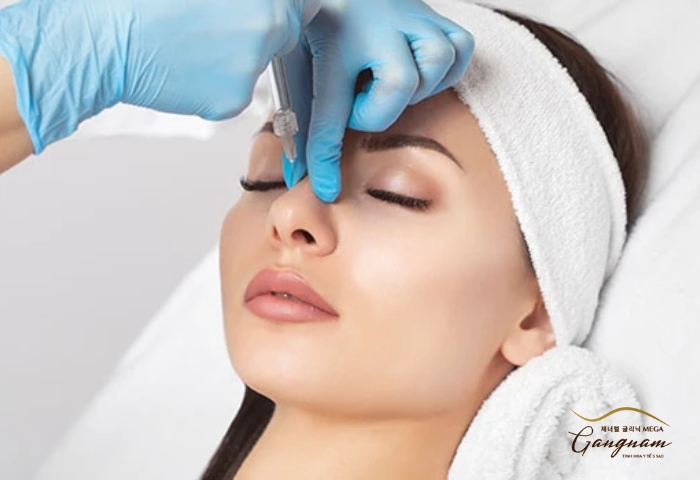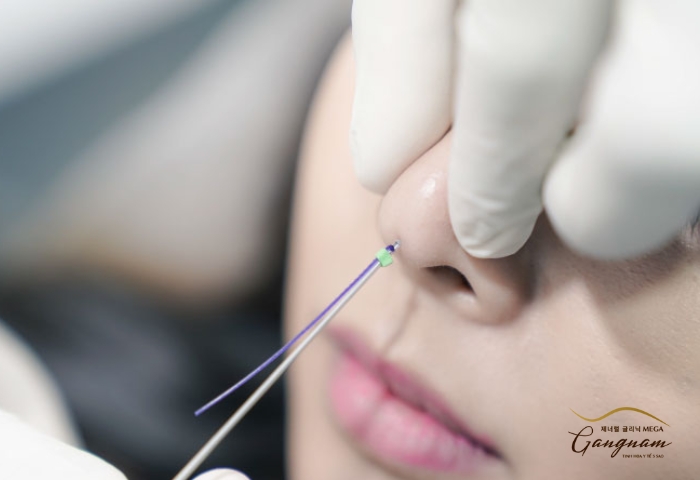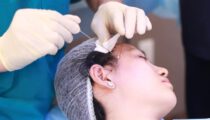Nose lift with filler: Procedure, effectiveness, maintenance duration
Nose lift with filler is a method that has gained significant attention among individuals seeking to enhance and reshape their noses in recent times. Unlike traditional surgical approaches, the use of filler injections for nose augmentation presents several advantages and helps mitigate certain unnecessary risks. However, is this method suitable for your specific goals? Refer to this article to gain a comprehensive understanding of the mechanisms, effectiveness, and duration of maintenance for the nose filler injection procedure!

How is the Nose Filler Procedure Performed? Is it Safe?
Using Nose Filler: How is it Done?
Not as complicated as traditional rhinoplasty and not requiring the precision of thread lifting, filler injection is a method chosen by many. Using filler for nose augmentation is one of the most popular cosmetic procedures today. It aims to add height to the nasal bridge and adjust the nose shape according to preferences without the need for surgery.
The mechanism of nose augmentation with filler involves injecting or implanting specific substances directly into the nose as indicated. The process of injecting nose filler must be performed by a professional cosmetic surgeon to ensure accuracy and safety for the body, as well as to minimize unwanted risks.
During the nose augmentation with filler, the doctor uses an ultra-thin needle to inject filler into specific areas of the nose, such as the nasal bridge, nasal tip, or any area that needs enhancement or alteration. The amount of filler and the injection site will be designed for each specific case.
Types of fillers used:
Hyaluronic Acid (HA): HA is a natural substance in the body and is widely used in nose filler. This ingredient has strong bonding properties, good water retention, and provides good elasticity. However, HA has good absorption properties, so it usually only lasts for 6 months to 1 year. Calcium Hydroxylapatite (CaHA): CaHA is a relatively thick filler that can create a lifting effect and quickly improve the nose’s shape, with longer-lasting results compared to HA. Nose augmentation with CaHA filler has a maintenance period of about 12 to 18 months. Poly-L-lactic Acid (PLLA): PLLA is a substance that stimulates the natural production of collagen in the skin. Injecting PLLA can produce results that last from 1 to 2 years. However, the initial nose augmentation effect may not be immediately apparent and may take time to take effect.
In addition to the mentioned nose fillers, there are still many components used to improve nose shape. However, the doctor is the one who decides which type of filler to use to suit the structure of the nose, your aesthetic goals, and your health condition. Avoid self-injecting nose filler at home to minimize unwanted side effects.
Benefits of nose filler injection method
In reality, the nose augmentation with filler method brings about many benefits. Especially for those with basic needs such as raising the nasal bridge, without the desire to undergo a complex and time-consuming surgery. Specifically, here are the strengths when choosing filler injection to enhance the nose:

Using Nose Filler and Its Amazing Benefits
- The process of nose augmentation with filler stops at using a small needle to inject the filling substance without the need for surgery. This helps avoid the risks and long-term recovery time commonly associated with traditional rhinoplasty surgeries.
- One of the significant benefits of using filler for nose augmentation is the immediate visibility of results. Right after the procedure (15-30 minutes), the nasal bridge will be elevated or shaped as desired.
- Using nose filler allows for relatively flexible adjustments to the shape and height of the nose. Cosmetic surgeons can alter the position and quantity of the filler to create natural and harmonious aesthetic results that complement each individual’s facial features.
- Nose filler injections typically pose no risk of leaving scars or unwanted marks on the surface, which is advantageous when compared to traditional rhinoplasty surgeries.
- If you wish to refine the results of nose augmentation over time, whether to enhance or change the nose’s shape, this can be achieved by injecting additional filler or removing existing filler from the nose.
- Compared to some other common nose augmentation surgical procedures, filler injections are considered to have fewer risks, especially regarding infection or complications from invasive surgery. Therefore, this is a safe and worthy option for you to consider.
Despite the numerous advantages, it’s essential to note that the results of nose augmentation with filler are not permanent and require periodic reinjection to maintain effectiveness. Choosing a reputable cosmetic clinic and an experienced doctor is crucial to meeting expectations after the procedure and ensuring our health’s safety.
Some limitations of the nose augmentation with filler method
Nose filler injections can be an excellent choice if we don’t have significant flaws in the nasal area or only have a basic need to alter the nose’s shape. Below are some drawbacks of the nose augmentation with filler method that you should consider to determine whether this cosmetic procedure meets your requirements:

Drawbacks of Using Nose Filler Method that You Need to Be Cautious About
Not Suitable for Every Case: Nose augmentation with fillers may not always align with our nasal enhancement goals. In certain cases, such as a deviated nasal bone structure, a scarred nose, or an overly low nasal bridge, more specialized approaches like thread lifting or traditional rhinoplasty might be more suitable choices.
Short-lived Results: The most significant limitation of nose filler augmentation is the relatively short duration of results. The filler substance gradually gets absorbed by the body over time, diminishing the initial effects. To maintain the desired outcome, periodic reinjections, approximately every six months, are necessary.
Possible Unusual Signs: While the recovery time after nose filler augmentation is generally shorter than with surgery, some temporary signs like difficulty breathing, temporary redness, or bruising in the nasal area and surrounding regions might occur. However, these symptoms usually subside within a few days after the injection.
Technical Requirements Must Be Met: Self-administering nose filler injections at home is not advisable as it requires high skills and in-depth knowledge of nasal structure. The expertise of the cosmetic surgeon is the most crucial factor determining the final results. Therefore, choosing a reputable cosmetic clinic for nose augmentation is essential.
Implementation Costs: The cost per nose filler injection is usually not high (around 2.5 – 3 million VND). However, considering the need for repeated sessions to maintain the desired effect, meticulous financial planning is crucial. There are various alternative options to consider, even if you prefer a non-surgical approach, so there’s no need to overly worry.
Rare Allergic Reactions or Complications: Although very rare, the filler injection process may lead to a few allergic reactions or complications such as infection, inflammation, or vascular issues.
Before deciding on nose augmentation with fillers, thorough discussion with a cosmetic surgeon is advised to ensure that this decision aligns with the nasal condition and personal goals. This also helps identify limitations and risks for timely consideration.
Evaluation of Nose Filler Method and Recommendations from the Cosmetic Surgeon
Opting for nose augmentation with fillers may be considered a safe choice for immediate nasal enhancement. However, it cannot be denied, based on the aforementioned information, that this method still reveals several limitations.

Consider the Thread Nose Lift Method for Its Impressive Benefits
Therefore, if you want a more comprehensive change to your nose, with longer-lasting results without undergoing surgery, you may consider the thread lifting method. In this process, the doctor uses special threads like collagen or collagen gold to lift and reshape the nose. This particular material promises a maintenance period 2-3 times longer than nose filler injections.
Some other benefits of the thread lifting nose augmentation method that you should consider:
- Effectiveness in Changing Nose Shape: Thread lifting for nose augmentation has the ability to adjust the nose shape more clearly and effectively compared to fillers. This is particularly important for those seeking distinct modifications to the nose shape or the height of the nasal bridge.
- No Need for Frequent Retouching: Due to its longer maintenance period, patients won’t need to undergo the procedure as often as with fillers. This saves time and costs associated with regular filler injections.
- Less Swelling and Bruising: Nose filler injections can cause temporary swelling and bruising in the nasal area and its surroundings. In contrast, the thread lifting method typically results in less swelling and bruising, allowing patients to return to normal activities more quickly.
This article provides information about nose filler methods along with detailed evaluations from experts. If you have any further questions, feel free to contact us directly through the Hotline: 093.770.6666 for immediate assistance!












